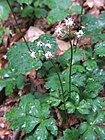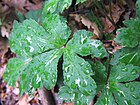Note: This is a project under development. The articles on this wiki are just being initiated and broadly incomplete. You can Help creating new pages.
Difference between revisions of "Sanicula europaea - Wood sanicle"
(→Uses) |
|||
| (7 intermediate revisions by 2 users not shown) | |||
| Line 1: | Line 1: | ||
[[File:Sanicula europaea 050606.jpg|thumb|right|''Wood sanicle'', ''Sanicula europaea'']] | [[File:Sanicula europaea 050606.jpg|thumb|right|''Wood sanicle'', ''Sanicula europaea'']] | ||
| − | + | '''Wood sanicle''' is a perennial plant of the family Apiaceae. Sanicula europaea is a perennial plant that can grow up to 0.60 metres tall. It is harvested from the wild for local use as a food and medicine. | |
| − | '''Wood sanicle''' is a perennial plant of the family Apiaceae. | ||
| − | |||
==Uses== | ==Uses== | ||
| − | {{Uses|Wounds}}, {{Uses| | + | {{Uses|Wounds}}, {{Uses|Internal bleeding}}, {{Uses|Cough}}, {{Uses|Blood disorders}}, {{Uses|Bleeding in the stomach}}, {{Uses|Bleeding in intestines}}, {{Uses|Nosebleeds}}, {{Uses|Chest complaints}}, {{Uses|Lung complaints}}, {{Uses|Diarrhea}}, {{Uses|Rashes}}. |
==Parts Used== | ==Parts Used== | ||
| − | {{Parts Used| | + | {{Parts Used|Leaves}}, {{Parts Used|Young shoots}}. |
==Chemical Composition== | ==Chemical Composition== | ||
| − | The fibrous root is the medicinal part. Its taste and odor are somewhat aromatic. An alcoholic tincture contains its medicinal properties. Resin, essential oil, tannin, coloring matters, and ash (9 per cent) were obtained from the root by C. J. Houck<ref name="chemical composition"/> | + | The fibrous root is the medicinal part. Its taste and odor are somewhat aromatic. An alcoholic tincture contains its medicinal properties. Resin, essential oil, tannin, coloring matters, and ash (9 per cent) were obtained from the root by C. J. Houck.<ref name="chemical composition"/> |
==Common names== | ==Common names== | ||
| − | {{Common names|kn=|ml=|sa=|ta=|te=|hi=|en= | + | {{Common names|kn=|ml=|sa=|ta=|te=|hi=|en= Wood sanicle}} |
==Properties== | ==Properties== | ||
| Line 42: | Line 40: | ||
===Fruit=== | ===Fruit=== | ||
| − | {{Fruit|Ovoid|5 mm| | + | {{Fruit|Ovoid|5 mm|Clearly grooved lengthwise, Lowest hooked hairs aligned towards crown||Many}} |
===Other features=== | ===Other features=== | ||
==List of Ayurvedic medicine in which the herb is used== | ==List of Ayurvedic medicine in which the herb is used== | ||
| − | |||
==Where to get the saplings== | ==Where to get the saplings== | ||
| Line 54: | Line 51: | ||
==How to plant/cultivate== | ==How to plant/cultivate== | ||
| − | Succeeds in any moist moderately fertile well-drained soil in sun or semi-shade | + | Succeeds in any moist moderately fertile well-drained soil in sun or semi-shade.<ref name="How to plant/cultivate"/> |
==Commonly seen growing in areas== | ==Commonly seen growing in areas== | ||
| − | {{Commonly seen| | + | {{Commonly seen|Thickets}}, {{Commonly seen|Damp places}}, {{Commonly seen|Near to acid soils}}, {{Commonly seen|Loamy soils}}. |
==Photo Gallery== | ==Photo Gallery== | ||
| Line 72: | Line 69: | ||
<references> | <references> | ||
| − | <ref name="chemical composition">[https://www.henriettes-herb.com/eclectic/kings/sanicula.html | + | <ref name="chemical composition">[https://www.henriettes-herb.com/eclectic/kings/sanicula.html Chemical constituents]</ref> |
| − | <ref name="Leaf">[http://www.luontoportti.com/suomi/en/kukkakasvit/sanicle | + | <ref name="Leaf">[http://www.luontoportti.com/suomi/en/kukkakasvit/sanicle Plant description]</ref> |
| − | <ref name="How to plant/cultivate">[https://www.pfaf.org/user/Plant.aspx?LatinName=Sanicula+europaea | + | <ref name="How to plant/cultivate">[https://www.pfaf.org/user/Plant.aspx?LatinName=Sanicula+europaea Cultivation details]</ref> |
</references> | </references> | ||
| Line 86: | Line 83: | ||
[[Category:Herbs]] | [[Category:Herbs]] | ||
| + | [[Category:Ayurvedic herbs that don't have seed photos]] | ||
| + | [[Category:Apiaceae]] | ||
Latest revision as of 13:31, 4 August 2020
Wood sanicle is a perennial plant of the family Apiaceae. Sanicula europaea is a perennial plant that can grow up to 0.60 metres tall. It is harvested from the wild for local use as a food and medicine.
Contents
- 1 Uses
- 2 Parts Used
- 3 Chemical Composition
- 4 Common names
- 5 Properties
- 6 Habit
- 7 Identification
- 8 List of Ayurvedic medicine in which the herb is used
- 9 Where to get the saplings
- 10 Mode of Propagation
- 11 How to plant/cultivate
- 12 Commonly seen growing in areas
- 13 Photo Gallery
- 14 References
- 15 External Links
Uses
Wounds, Internal bleeding, Cough, Blood disorders, Bleeding in the stomach, Bleeding in intestines, Nosebleeds, Chest complaints, Lung complaints, Diarrhea, Rashes.
Parts Used
Chemical Composition
The fibrous root is the medicinal part. Its taste and odor are somewhat aromatic. An alcoholic tincture contains its medicinal properties. Resin, essential oil, tannin, coloring matters, and ash (9 per cent) were obtained from the root by C. J. Houck.[1]
Common names
| Language | Common name |
|---|---|
| Kannada | |
| Hindi | |
| Malayalam | |
| Tamil | |
| Telugu | |
| Marathi | NA |
| Gujarathi | NA |
| Punjabi | NA |
| Kashmiri | NA |
| Sanskrit | |
| English | Wood sanicle |
Properties
Reference: Dravya - Substance, Rasa - Taste, Guna - Qualities, Veerya - Potency, Vipaka - Post-digesion effect, Karma - Pharmacological activity, Prabhava - Therepeutics.
Dravya
Rasa
Tikta (Bitter), Kashaya (Astringent)
Guna
Laghu (Light), Ruksha (Dry), Tikshna (Sharp)
Veerya
Ushna (Hot)
Vipaka
Katu (Pungent)
Karma
Kapha, Vata
Prabhava
Habit
Identification
Leaf
| Kind | Shape | Feature |
|---|---|---|
| Simple | Alternate | Basal leaves long-stemmed, overwintering, stem leaves usually 1, stalkless |
Flower
| Type | Size | Color and composition | Stamen | More information |
|---|---|---|---|---|
| Unisexual | 2–3 mm | Reddish–white | 5 | Inflorescence a compound umbel, secondary umbels compounded. Primary and secondary umbels with bracts and Flowering time is June–July |
Fruit
| Type | Size | Mass | Appearance | Seeds | More information |
|---|---|---|---|---|---|
| Ovoid | 5 mm | Clearly grooved lengthwise, Lowest hooked hairs aligned towards crown | Many | {{{6}}} |
Other features
List of Ayurvedic medicine in which the herb is used
Where to get the saplings
Mode of Propagation
How to plant/cultivate
Succeeds in any moist moderately fertile well-drained soil in sun or semi-shade.[3]
Commonly seen growing in areas
Thickets, Damp places, Near to acid soils, Loamy soils.
Photo Gallery
References
External Links
- Ayurvedic Herbs known to be helpful to treat Wounds
- Ayurvedic Herbs known to be helpful to treat Internal bleeding
- Ayurvedic Herbs known to be helpful to treat Cough
- Ayurvedic Herbs known to be helpful to treat Blood disorders
- Ayurvedic Herbs known to be helpful to treat Bleeding in the stomach
- Ayurvedic Herbs known to be helpful to treat Bleeding in intestines
- Ayurvedic Herbs known to be helpful to treat Nosebleeds
- Ayurvedic Herbs known to be helpful to treat Chest complaints
- Ayurvedic Herbs known to be helpful to treat Lung complaints
- Ayurvedic Herbs known to be helpful to treat Diarrhea
- Ayurvedic Herbs known to be helpful to treat Rashes
- Herbs with Leaves used in medicine
- Herbs with Young shoots used in medicine
- Herbs with common name in English
- Habit - Herb
- Index of Plants which can be propagated by Seeds
- Index of Plants which can be propagated by Cuttings
- Herbs that are commonly seen in the region of Thickets
- Herbs that are commonly seen in the region of Damp places
- Herbs that are commonly seen in the region of Near to acid soils
- Herbs that are commonly seen in the region of Loamy soils
- Herbs
- Ayurvedic herbs that don't have seed photos
- Apiaceae






